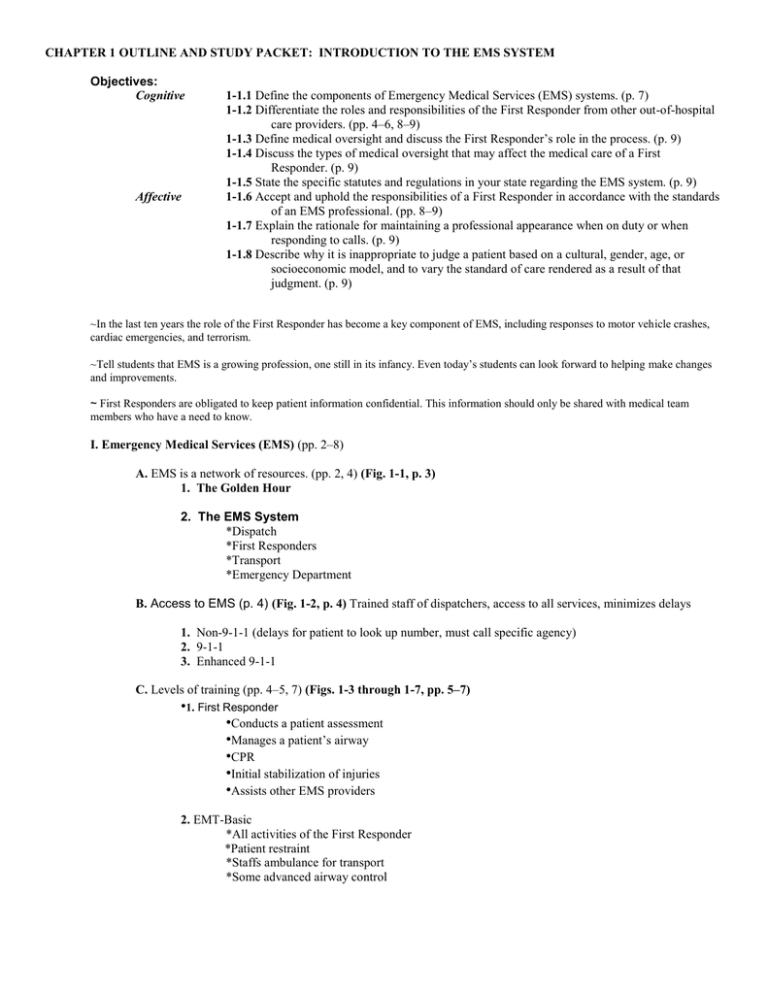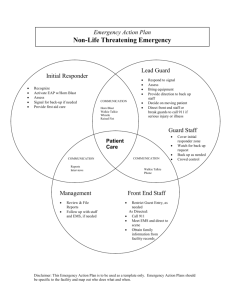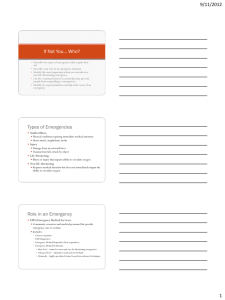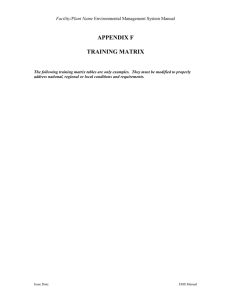Chapter 1 True or False
advertisement

CHAPTER 1 OUTLINE AND STUDY PACKET: INTRODUCTION TO THE EMS SYSTEM Objectives: Cognitive Affective 1-1.1 Define the components of Emergency Medical Services (EMS) systems. (p. 7) 1-1.2 Differentiate the roles and responsibilities of the First Responder from other out-of-hospital care providers. (pp. 4–6, 8–9) 1-1.3 Define medical oversight and discuss the First Responder’s role in the process. (p. 9) 1-1.4 Discuss the types of medical oversight that may affect the medical care of a First Responder. (p. 9) 1-1.5 State the specific statutes and regulations in your state regarding the EMS system. (p. 9) 1-1.6 Accept and uphold the responsibilities of a First Responder in accordance with the standards of an EMS professional. (pp. 8–9) 1-1.7 Explain the rationale for maintaining a professional appearance when on duty or when responding to calls. (p. 9) 1-1.8 Describe why it is inappropriate to judge a patient based on a cultural, gender, age, or socioeconomic model, and to vary the standard of care rendered as a result of that judgment. (p. 9) ~In the last ten years the role of the First Responder has become a key component of EMS, including responses to motor vehicle crashes, cardiac emergencies, and terrorism. ~Tell students that EMS is a growing profession, one still in its infancy. Even today’s students can look forward to helping make changes and improvements. ~ First Responders are obligated to keep patient information confidential. This information should only be shared with medical team members who have a need to know. I. Emergency Medical Services (EMS) (pp. 2–8) A. EMS is a network of resources. (pp. 2, 4) (Fig. 1-1, p. 3) 1. The Golden Hour 2. The EMS System *Dispatch *First Responders *Transport *Emergency Department B. Access to EMS (p. 4) (Fig. 1-2, p. 4) Trained staff of dispatchers, access to all services, minimizes delays 1. Non-9-1-1 (delays for patient to look up number, must call specific agency) 2. 9-1-1 3. Enhanced 9-1-1 C. Levels of training (pp. 4–5, 7) (Figs. 1-3 through 1-7, pp. 5–7) •1. First Responder •Conducts a patient assessment •Manages a patient’s airway •CPR •Initial stabilization of injuries •Assists other EMS providers 2. EMT-Basic *All activities of the First Responder *Patient restraint *Staffs ambulance for transport *Some advanced airway control 3. EMT-Intermediate *All EMT-Basic functions *Limited medication administration *Manual defibrillation 4. EMT-Paramedic *All EMT-Intermediate functions *Advanced airway management *Cardiac monitoring *Expanded medication administration D. Classic Components of EMS (p. 7) 1. Regulation and policy 2. Resources management 3. Human resources and training 4. Transportation 5. Facilities 6. Communications 7. Public information and education 8. Medical oversight 9. Trauma systems 10. Evaluation E. In-hospital care system (p. 6) –Specialized medical facilities •Trauma centers •Burn centers •Pediatric centers –Local hospital emergency departments II. The First Responder (pp. 8–9) A. Role (p. 8) 1. Ensuring safety (yourself, patient, crew, and bystanders) 2. Gaining access to patient 3. Assessing patient for life threats 4. Alerting additional EMS resources 5. Providing care based on assessment findings 6. Assisting other EMS personnel 7. Participating in record keeping and data collection 8. Acting as liaison with other public safety workers B. Responsibilities (pp. 8–9) 1. Guarding personal health and safety 2. Maintaining a caring attitude 3. Maintaining composure 4. Keeping a professional appearance 5. Maintaining up-to-date knowledge and skills 6. Maintaining current knowledge of EMS III. Medical Oversight (p. 9) A. Medical director B. Medical control, direct and indirect (standing orders and protocols) C. First Responder as designated agent of medical direct Chapter 1 True or False Indicate if the following statements are true or false by writing T or F in the space provided. ______ 1. As a First Responder, the emergency care you provide to patients may be considered by law an extension of the medical director’s authority. ______ 2. First Responders may be called to emergencies where they are the only trained rescuers on scene. ______ 3. As a First Responder, you must consider your own safety only after you have provided emergency care to your patients. ______ 4. Being well dressed and groomed is not important to the professional responsibilities of a First Responder. ______ 5. When a patient needs transport to a hospital, you may leave the scene after you verify that an ambulance will arrive in five minutes or less. ______ 6. As a First Responder, you are expected to be aware of local, state, and national issues affecting the EMS system. ______ 7. According to the U.S. DOT, each state must have a quality improvement system in place for continuing evaluation and upgrading of its EMS system. ______ 8. The National Registry of Emergency Medical Technicians offers examinations for certification of EMS responders. ______ 9. Standing orders and protocols that spell out accepted practice are a form of direct medical control. ______10. A trauma center is a medical facility specializing in the treatment of infants and children. The Call: First on Scene Read the scenario. Then answer the questions that follow. You and your partner are assigned to EMS Unit 5 one morning in September. At 10:35 A.M., the emergency dispatcher directs you to a collision on Pumpkin Hollow Road. Someone called to report that the car ahead of her had swerved to avoid a dog, gone off the road, plunged into a ditch, and hit a tree. Dispatch reports that an ambulance is en route and will arrive on scene in about 15 minutes. Your unit pulls up to the scene six minutes later. After determining that the scene is safe to enter, you approach the crash site. As you don your personal protective equipment, you focus on the young man sit- ting on the ground beside the crashed car. His shirt and pants are blood soaked. He is apparently alert and holding his wrist tightly with his other hand. The patient tells you that after the crash, he had not believed himself injured and attempted to get out of the car. In doing so, he sliced his wrist on jagged metal. He tells you that he had been wearing a seat belt. Your partner applies direct pressure to the wound. Meanwhile, you introduce yourself to the patient and begin your assessment of his condition. The patient seems anxious and restless. As you continue to assess him, you explain what you are doing and try to calm him. Because of the possible mechanisms of injury involved in the crash, you are especially alert to the possibility of spine and other internal injuries. You administer high-flow oxygen to the patient and join your partner in manually stabilizing the patient to avoid any further injury. Seven minutes later, the paramedics arrive. You provide them with a concise report of the patient’s condition and your interventions. The paramedics assume care of the patient, contact medical direction, and report on their findings and expected time of arrival at the hospital. Just a few minutes after 11:00 A.M., the ambulance reaches the hospital. The paramedics brief the emergency department staff on the patient’s status and the care he has received. The hospital crew takes over and wheels the young man off to surgery. 1. What EMS resources were involved in this scenario? 2. What roles and responsibilities of a First Responder were demonstrated in this scenario? Chapter 1 Review In the space provided, write the word or words that best complete each sentence. 1. In general, the _____________________ _____________________ _____________________ system is a network of resources that provides emergency medical care to victims of sudden illness or injury. 2. A typical example of an emergency call begins with a member of the public calling _____________________ or other emergency number. 3. An important member of the EMS team, the emergency medical _____________________ receives emergency calls at a public safety answering point. 4. An emergency communication system that automatically records a caller’s phone number and location is known as an _____________________ 9-1-1 system. 5. There are four levels of training. They are _____________________ , ___________________ , _____________________ , and _____________________ . 6. A _____________________ _____________________ is the first person with emergency medical training on the scene. 7. At the next level of EMS training after First Responder, the EMT- _____________________ can also perform complex immobilization procedures, restrain patients, and staff and drive ambulances. 8. First Responders and EMTs provide _____________________ care, or emergency medical treatment before transport to a medical facility. 9. The _____________________ _____________________ is legally responsible for all clinical and patient-care aspects of an EMS system. 10. Standing orders and protocols are examples of _____________________ medical control






